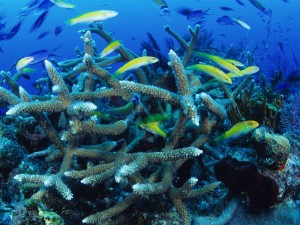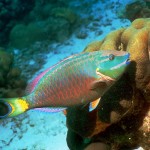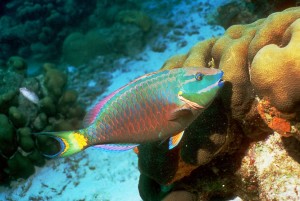Newly arrived species mow down vegetation and upend local communities.
This spotlight parrot fish (Sparisoma viride) was spotted grazing on coral near the island of Bonaire in the Caribbean.PHOTOGRAPH BY AGE FOTOSTOCK SPAIN, S.L. VIA ALAMY
for National Geographic
PUBLISHED JULY 25, 2014Marine ecologist Adriana Vergés emerged from a scuba dive in Tosa Bay off the coast of southern Japan last week and was amazed at what she’d seen: A once lush kelp forest had been stripped bare and replaced by coral.The bay is hundreds of miles north of the tropics, but now “it feels like a tropical place,” said Vergés, a lecturer at New South Wales University in Australia.The undersea world is on the move. Climate change is propelling fish and other ocean life into what used to be cooler waters, and researchers are scrambling to understand what effect that is having on their new neighborhoods. They are finding that the repercussions of the migration of tropical fish, in particular, are often devastating. Invading tropical species are stripping kelp forests in Japan, Australia, and the eastern Mediterranean and chowing down on sea grass in the northern Gulf of Mexico and Atlantic seaboard.
“The faunas are mixing, and nobody can see what the outcome will be,” said Ken Heck, a marine scientist at the University of South Alabama in Mobile. But the consequences of that mixing are already trickling up the food chain.
Voracious Eaters
Sea grass beds and kelp forests are often known as the sea’s nurseries because they have nooks and crannies filled with nutrients that feed and protect fish larvae and juveniles. The kelp and sea grass, however, are being replaced with other warm-water species such as coral that follow the arrival of tropical fish, said Vergés.
Vergés and her colleagues recently documented how tropical fish, which are normally a beneficial companion to coral beds, can devastate a kelp forest. Their study appeared July 9 in the Proceedings of the Royal Society B.
Many tropical fish species are “browsers” or “scrapers” that clean coral of algae and plants that could otherwise choke the reefs. But when the herbivorous fish move toward more temperate waters, they often find a bountiful harvest of kelp or sea grass to feed their voracious appetites.
Once a tropical fish species arrives in a new area, it can quickly mow down vegetation and algae and destroy the lush habitat that protects other species. For instance, “parrotfish are capable of eating a lot of sea grass per individual,” said marine scientist Joel Fodrie of the University of North Carolina at Chapel Hill.
Tropical rabbitfish have been swimming in the Mediterranean Sea since 1869 when they slipped in through the newly opened Suez Canal from the Red Sea. But the warming of the Mediterranean has allowed their numbers to explode in recent decades, and the fish have deforested hundreds of miles of kelp there, Vergés said.
The shrimp, crab, and other species that often spend the first year of their lives hiding from predators in the protection of the grasses disappear when their cover is gone, leaving a void for the creatures that depend on them. The loss of vegetation can completely change the community of species that live there, Vergés said. “If you dive in a kelp forest, you find a very different fish community than if you dive in a coral-dominated area.”
The removal of a kelp forest or sea grass bed can have devastating effects not only on native plants and animals, but also on commercial fisheries. In southern Japan, for example, the arrival of rabbitfish and parrot fish destroyed as much as 40 percent of the kelp forests there. These lush areas were once thick with abalone and spiny lobster, which supported a famed fishery. But when the kelp disappeared, so did the abalone and spiny lobster, and the fishery plummeted.
A photo of a Blue Headed Wrasse on coral.
Bluehead wrasse, native to the Caribbean and Gulf of Mexico, dart among coral.

PHOTOGRAPH BY MICHAEL PATRICK O’NEILL, ALAMY
Fish on the Move
In the northern Gulf of Mexico, Heck started seeing unusual species several years ago as he pulled specimens from the water near the Dauphin Island Sea Lab south of Mobile.
“It wasn’t just one or two. There were many. It got me thinking, this is something different,” Heck said.
Working in the Gulf, Heck and Fodrie netted 128,000 fish in 2006 and 2007 and compared the numbers of tropical fish in their trawl nets with records from the 1970s. They found a 22-fold increase in emerald parrot fish—a coral cleaner common in the Caribbean and the waters off Latin America—and new arrivals of snapper, grouper, butterfly fish, and surgeonfish, among others, they reported in Global Change Biology in 2009. Green sea turtles and manatees have also found northern Gulf waters increasingly comfortable, Heck said.
Heck and Fodrie are updating their research and said they expect to find large changes in the food webs of the Gulf as coral moves into areas overgrazed by tropical fish, and as the crabs and shellfish that depend on the sea grass dwindle.
“People are seeing these fish all over the world” in unexpected places, Heck said. “I don’t think there’s any question that the movement of many tropical species is related to the warming of coastal waters.”
Warming Waters
Climate change has warmed the ocean surface by an average of a little more than one degree Celsius in the past century, but the warming has not been uniform. Currents have created “hot spots” in temperate oceans, where temperatures have risen two to three times more than the global average, according to Vergés. In those hot spots, tropical species have been able to move in after the minimum temperature in winter has reached a tolerable level.
Fodrie said the research in the Gulf found the minimum temperature on the coolest days in the winter had inched up by as much as 3 degrees Celsius, an open invitation for fish that like warmer water. “That’s huge,” Fodrie said. “When you do the geographic comparison, it’s like moving from the northern Gulf down to Miami.” That has let species more common off Miami, for example—such as snappers, groupers, and parrot fish-become established in the northern Gulf of Mexico and up the Atlantic seaboard.
Florida’s famous stone crabs have been found in the Carolinas, and the Chesapeake’s blue crabs have been seen as far north as New York, Fodrie said. He has seen colorful tropical species, such as angelfish and damselfish, off the Carolinas. Plants, too, are on the march: Black mangroves are growing miles farther north along the Florida coast than they were a decade or so ago, Fodrie said.
Devastation doesn’t always follow when tropical species move poleward. Some fish and other plants and animals in more temperate waters are moving, as well—when they can.
“In the Gulf of Mexico, they can’t do that,” Heck said. “The North American continent is in the way. These native species really don’t have anywhere to go.”
Species on land and in the oceans have always moved around, but now climate change is increasing the speed of this movement, Vergés said. “There’s no doubt. The magnitude of the change is so large that it’s very obvious.”
Regions are losing and gaining species, but the overall result is a decline in biodiversity. “It’s a fascinating phenomenon that is happening right now,” Vergés said. “It’s alarming, as well. But as a scientist, I’m focusing on the exciting.”
Follow Doug Struck on Twitter.

